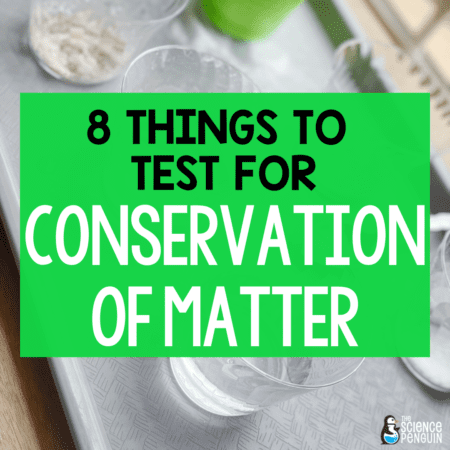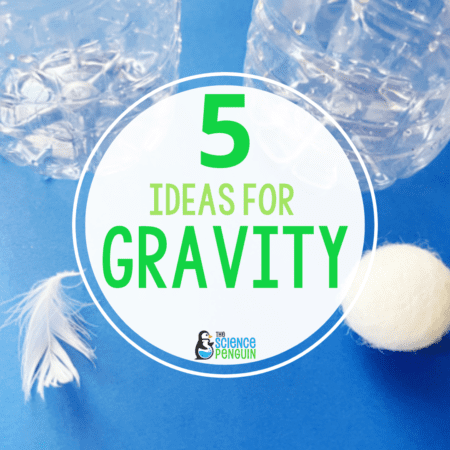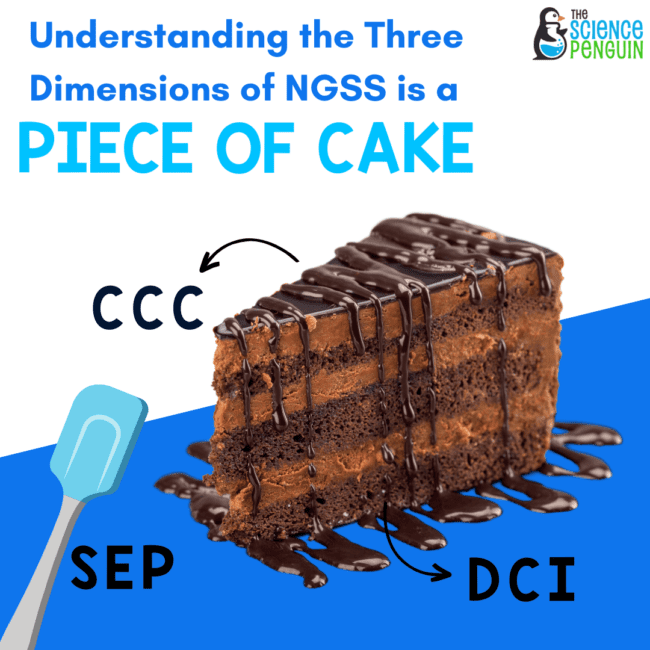
Picture a science classroom where students aren’t just passive learners, but active investigators who ask questions, conduct experiments, analyze data, and solve real-world problems. 🧠💡The key to this type of learning lies in the three dimensions woven throughout the NGSS. 🧵
Maybe you’ve even already heard of these three dimensions but haven’t taken the dive yet into figuring out how they’ll work in your classroom. Read on to learn more about this dynamic and engaging approach to teaching science.
The structure of the NGSS is divided into three dimensions. These three dimensions – Disciplinary Core Ideas (DCIs), Science and Engineering Practices (SEPs), and Crosscutting Concepts (CCCs) – might sound complex, but with a little guidance, some real-life examples, and even some [free!] resources, you’ll be well on your way to teaching engaging and effective science lessons with your students.
This three-dimensional approach to teaching science shifts instruction from lectures and textbook-based learning to a focus on inquiry-based instruction, exploration, and developing evidence-based responses to scientific learning.
A Piece of Cake
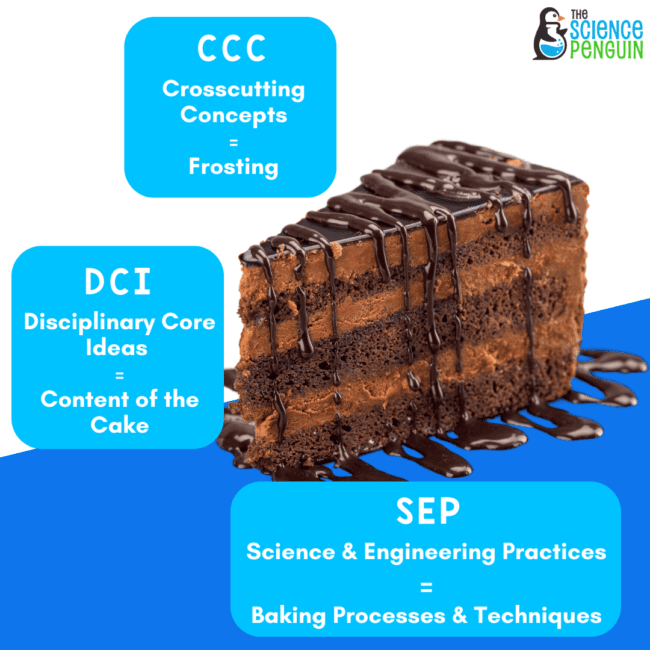
One way to understand the three dimensions of the NGSS is to think about baking a cake. A chocolate cake represents the performance expectation – this is what teachers are helping students work towards at the end of the lesson or unit. The three dimensions of NGSS can be represented as the components of the cake:
-
- The processes that go into making the cake, like the baking tools and techniques, represent the Science and Engineering Practices (SEPs).
-
- The content of the cake itself represents the Disciplinary Core Ideas (DCIs).
-
- The frosting represents the Crosscutting Concepts (CCCs), a layer that enhances the cake and can be found on other desserts, like cupcakes or cookies.
The Science and Engineering Practices can be seen as “doing” the science, the Disciplinary Core Ideas are the facts or content students are learning, and the Crosscutting Concepts represent the themes that connect knowledge across the content students are learning.
Let’s dig a little deeper into each dimension.
Disciplinary Core Ideas: The “Content”
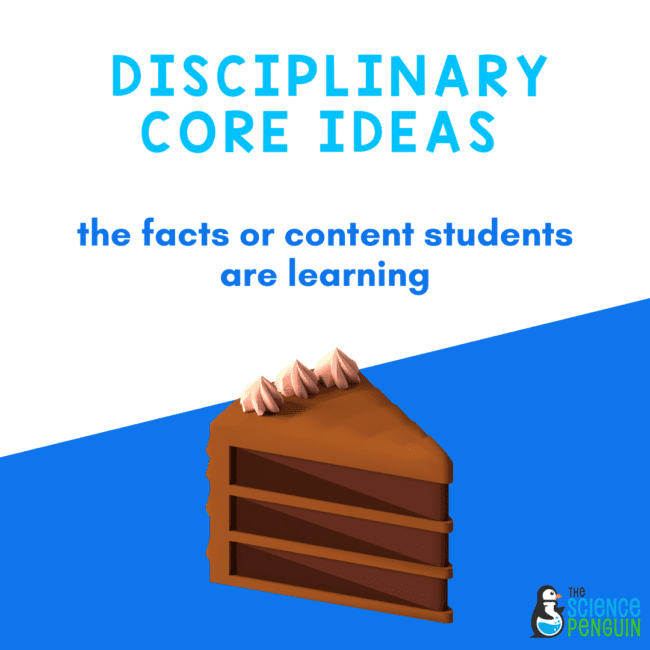
Disciplinary Core Ideas (DCIs) are the foundational science ideas and concepts that students need to understand. These ideas provide the content for your lessons, and they’re likely most similar to the content standards you have taught in your classroom previously.
One thing you might notice about the DCIs is that there are fewer content areas you’ll need to cover. This is because the structure of NGSS moves away from the “mile wide, inch deep” approach to science education. Instead, there is an emphasis on providing more time for students to engage in scientific investigations and supporting students in building a deeper understanding of science concepts.
The NGSS organizes the Disciplinary Core Ideas into four major domains:
-
- Physical Sciences (PS)
-
- Life Sciences (LS)
-
- Earth and Space Sciences (ESS)
-
- Engineering, Technology, and the Applications of Science (ETS)
Each domain includes grade-appropriate concepts that build upon one another as students progress through their education.
These four disciplines are divided into Disciplinary Core Ideas (DCIs). These are the “big ideas” of each field. For example, the DCIs under the Earth and Space Science (ESS) discipline are ESS1 (Earth’s Place in the Universe), ESS2 (Earth’s Systems), and ESS3 (Earth and Human Activity).
Each DCI is further subdivided into component ideas. These are more specific concepts within the broader DCIs, and they build on each other across the K-12 grades. They are identified using DCI codes and letters, like ESS1.A, ESS11.B, and ESSS1.C.
In our NGSS-aligned Phenomena-Based Science Units, each unit is aligned to a specific DCI. For example, in the Plants Phenonema-Based Science Unit, the fifth grade DCI for LS1-1 is the focus of the content within the unit. The DCI states, “Support an argument that plants get the materials they need for growth chiefly from air and water.” In this unit, students investigate whether plants need air, water, and soil through investigations, text readings, data collection, creating models, and more! Check out more of our NGSS-aligned science resources HERE.
Science and Engineering Practices: “Doing the Science”

Science and Engineering Practices (SEPs) are the processes through which students engage with and explore scientific ideas. These practices emphasize critical thinking, problem solving, and collaboration. There are eight Science and Engineering Practices:
-
- Asking and answering questions and defining problems
- Developing and using models
- Planning and carrying out investigations
- Analyzing and using data
- Using mathematics and computational thinking
- Constructing explanations and designing solutions
- Engaging in argument from evidence
- Obtaining, evaluating, and communicating information
Integrating these practices into lessons allows students to actively explore scientific concepts and develop critical thinking skills. As a result, students are directly involved in processes that model how real scientists and engineers investigate, model, and explain the world.
The goal of using SEPs alongside the content of the DCIs is for students not only to “know” science concepts but for them also to use their understanding of science concepts to solve real-world problems and understand how scientific knowledge is generated and applied.
Not sure where to start with using the Science and Engineering Practices in your classroom? Each of our NGSS-aligned Phenomena-Based Science Units integrates the SEPs, making it easy for you to plan and prep your lessons! For example, in our Mapping Disasters Phenomena-Based Science Unit, students work on SEP #2 as they design a model of a seismograph and SEP #6 as they track evidence gathered throughout the unit on a class Claim-Evidence-Response chart. At the end of the unit, students construct explanations using evidence collected from the activities, investigations, and readings to answer this question: How can we use maps to reduce the impact of natural disasters?
Crosscutting Concepts: Making Connections
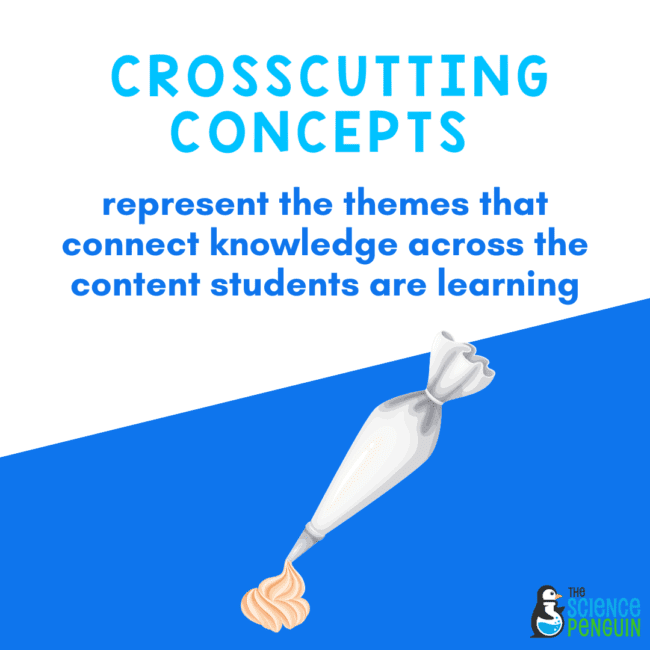
Crosscutting Concepts (CCCs) are themes that apply across all domains of science. They are used in the NGSS to help students recognize patterns across disciplines.
There are seven Crosscutting Concepts:
-
- Patterns
- Cause and effect
- Scale, proportion, and quantity
- Systems and systems models
- Energy and matter
- Structure and function
- Stability and change
By incorporating CCCs, educators help students make connections to different content areas.
Making connections across the domains of science helps students make sense of new content and to solve complex problems. It also encourages students to be flexible and creative and to develop their ideas over time.
For example, after completing an earth science unit on the water cycle, students are able to use their knowledge and experience in systems and system models (CCC #4) to connect with new knowledge gained in a life science unit about human body systems.
In our Gravity Phenonemna-Based Science Unit, the Crosscutting Concept of cause and effect is woven throughout the unit. Students explore how parachutes impact the effect of gravity on a falling object, engaging in hands-on activities and making connections to previous knowledge about cause and effect relationships.
Let’s Cut the Cake: Wrapping Up
By integrating these dimensions in the NGSS, educators can help students develop a deeper understanding of scientific principles, apply critical thinking skills to real-world problems, and make meaningful connections across the science disciplines.
Putting together the DCIs, SEPs, and CCCs (and all the other acronyms we use daily!) can feel like a juggling act at first, but don’t worry. We’ve studied the NGSS standards in depth and have developed an amazing planning tool to get you started on your science journey. We’ve got you covered with our FREE 48-page guide with day-by-day activity suggestions to accompany your Science Penguin resources. Make your lesson planning easier and download your science planning guide today!

Sign up with your personal email and check your email now for immediate access to a full year of science planning ideas for 4th grade NGSS.

Sign up with your personal email and check your email for immediate access to a full year of science planning ideas for 5th grade NGSS.

